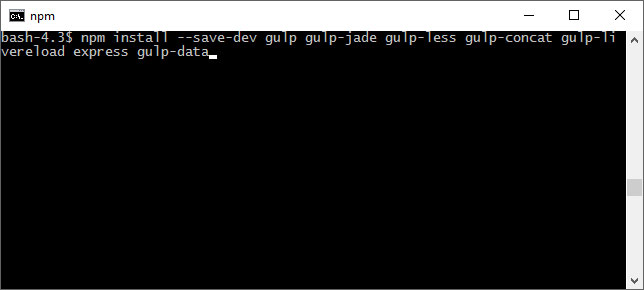Setting Up a Development Environment with Jade, SASS, Less, and NPM
Prerequisites:
Install NPM.
Step 1:
Create Directory
Step 2:
Make a new gulp file named gulpfile.js
Step 3:
Copy and paste these dependencies into your gulpfile:
var gulp = require('gulp'); // build system
var jade = require('gulp-jade'); // jade allows to build html markup quickly
var rename = require('rename');
var gulp = require('gulp'); // build system
var jade = require('gulp-jade'); // jade allows to build html markup quickly
var rename = require('rename');
var less = require('gulp-less'); // less allows you to build css files.
var concat = require('gulp-concat'); // concentrates certain files
var livereload = require('gulp-livereload') // reloads browser when updating certain files. Works with live reload chrome extension.
var express = require('express'); // web server
var app = express(); // refrences the express web server
var gutil = require('gulp-util'); // utility functions and log for gulp plugins (optional)
var path = require('path'); // used by express server
var data = require('gulp-data'); // connects to jason file.
npm init
This asks a series of questions about your project and creates a package.json file in your project directory. Answer the questions as you wish.
Step 5: now run the following command to install the dependencies above.
Step 1:
Create Directory
Step 2:
Make a new gulp file named gulpfile.js
Step 3:
Copy and paste these dependencies into your gulpfile:
var gulp = require('gulp'); // build system
var jade = require('gulp-jade'); // jade allows to build html markup quickly
var rename = require('rename');
var gulp = require('gulp'); // build system
var jade = require('gulp-jade'); // jade allows to build html markup quickly
var rename = require('rename');
var less = require('gulp-less'); // less allows you to build css files.
var concat = require('gulp-concat'); // concentrates certain files
var livereload = require('gulp-livereload') // reloads browser when updating certain files. Works with live reload chrome extension.
var express = require('express'); // web server
var app = express(); // refrences the express web server
var gutil = require('gulp-util'); // utility functions and log for gulp plugins (optional)
var path = require('path'); // used by express server
var data = require('gulp-data'); // connects to jason file.
Step 4:
Open up a command prompt, I use GitBash, by right clicking in the directory you created and run:npm init
This asks a series of questions about your project and creates a package.json file in your project directory. Answer the questions as you wish.
Step 5: now run the following command to install the dependencies above.
npm install --save-dev gulp gulp-jade gulp-less gulp-concat gulp-livereload express gulp-data
To check if all packages have been installed you can run the following command:npm list -dev --depth=0
..to be continued.

Comments
Post a Comment